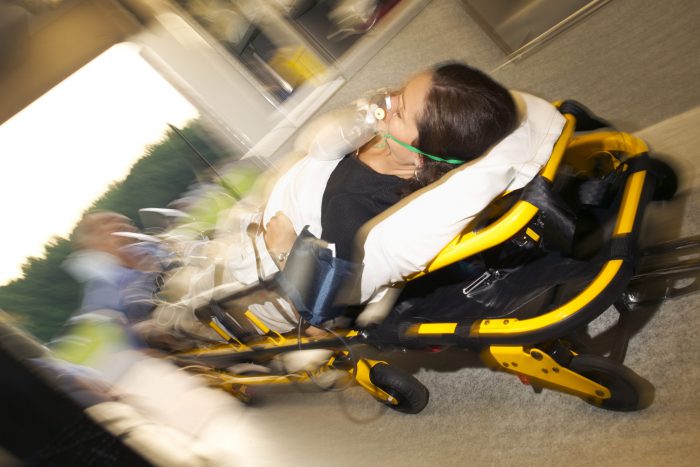Wisconsin Sees Success in Stroke Outreach Using Community Education
Success Story from the Paul Coverdell National Acute Stroke Program
Overview

Optimal stroke care begins with early recognition of the signs of stroke and calling 9-1-1. The Wisconsin Ambulance Run Data System (WARDS) shows that in 2013 only 40% of stroke patients arrived at Wisconsin hospitals by emergency medical services (EMS). Studies have shown that stroke patients who arrive at an emergency department by EMS receive faster care. At Moundview Memorial Hospital, Lisa Massen, RN, emergency department manager, knew that educating the community about calling 9-1-1 could lead to better outcomes for stroke patients.
Challenge and Approach
In late 2015, after several Stroke Systems of Care Task Force meetings led by the Rural Wisconsin Health Cooperative and the Wisconsin Coverdell Stroke Program, Ms. Massen became curious about how her hospital was doing in terms of EMS arrivals. The results were shocking: In the second quarter of 2015, none of Moundview’s stroke patients arrived by EMS; in the third quarter, just 50% came in by ambulance; in the fourth, only 25% did.
“The data we collected showed poor or inconsistent results, particularly around our EMS arrival rate, which was cause for concern,” said Ms. Massen.
While hospital leadership recognized that there were several areas where the hospital could potentially devote resources to improving stroke care, the data were clear: The EMS arrival rate needed the most attention.
Ms. Massen learned that community outreach was a primary focus of quality improvement projects at several other Wisconsin hospitals. She and her staff recognized community outreach as a strategy they could use to improve Moundview’s stroke patient EMS arrival rate. Ms. Massen educated staff on the data collected and the importance of community outreach in quality improvement.
Moundview leadership provided staff with the appropriate tools and messaging and offered opportunities for staff to get involved.
Upon receiving materials from the Wisconsin Coverdell Stroke Program, including magnets, bookmarks, and blood pressure wallet cards, Ms. Massen and other staff members went to work. Tammy Lowrey, marketing and community relations manager, and Maureen Bruce, quality director, were integral in supporting Moundview’s community outreach efforts.
Ms. Bruce began discussions about starting a stroke community outreach program near the Moundview clinic in Friendship, Wisconsin, and led several brainstorming sessions related to these outreach efforts.
Ms. Lowrey provided logistical support and coordination for many of Moundview’s community outreach efforts, including arranging speaking engagements, writing newspaper op-eds, compiling patient testimonials, coordinating volunteers, setting up exhibit booths, and even designing a stroke education float for the Friendship Fourth of July parade. These presentations helped highlight the important role of EMS in the process, earning public buy-in about calling 9-1-1 in stroke cases.
These efforts led to strikingly positive results. In the second quarter of 2016, every stroke patient treated at Moundview arrived by ambulance. Moundview has sustained an exceptionally high EMS arrival percentage ever since. Future patient post-care surveys may include a question to help Moundview collect more concrete data regarding the effectiveness of specific outreach strategies.
Barriers and Challenges
Small hospital with limited resources. Moundview has demonstrated that a hospital doesn’t need an overabundance of funding or resources to make an impact. Despite its small size and limited funds, the hospital was able to improve its EMS arrival rate for stroke patients with the help of the Coverdell Program’s free materials and the buy-in of all staff, from leadership to frontline workers.
Lack of existing quality improvement process. Given that Ms. Massen and her staff couldn’t draw inspiration from existing model programs, figuring out what kind of project to take on was a challenge.
“We started by collecting data on EMS arrivals and the stroke alert process,” Ms. Massen said. “It was necessary for us to collect data before we could begin exploring quality improvement project options, and the data ultimately helped us choose our first quality improvement goal.”
Accomplishments
The results of Moundview’s community outreach efforts were overwhelmingly positive. The hospital has maintained a near 100% EMS arrival rate for stroke patients since late 2015.
When Moundview started this project in 2015, the hospital had no stroke quality improvement projects or initiatives in place. Before staff began their first project, it was important to collect data.
Moundview decided to focus data collection efforts on the following:
- Use of the clot-busting drug alteplase.
- Percentage of stroke patients who arrived by EMS.
- Use of the stroke alert process, including door-to-computed tomography (CT) scan times and stroke scale numbers.
After realizing that stroke patient arrivals by EMS were the most inconsistent of their stroke care measures, Ms. Massen and her team made prehospital arrivals their first quality improvement goal.
The team determined that the most efficient place to start was community outreach around stroke signs and symptoms and calling 9-1-1.
Lessons Learned

Prioritize outcomes. Moundview focused on data, strategies, and techniques that would improve stroke care in measurable ways.
Focus on internal communication and teamwork. The quality improvement program was successful because of the continued efforts of EMS and emergency department and ancillary staff, including lab and radiology workers.
Buy-in at all levels is essential. Buy-in starts with ensuring that the community trusts Moundview and the local EMS agency to provide prompt care to stroke patients. Community participation is just as important to improving stroke outcomes as community outreach is.
Data collection and evaluation are crucial to success. Data collection helped document where Moundview started, how it improved and how quickly, and whether those improvements were temporary or sustained. Data also allowed Moundview to set benchmarks for staff to know how they are doing. Without effective data evaluation, it is difficult to know whether a specific intervention must be continued indefinitely or can be done once and have a lasting effect.
Next Steps
Moundview continues to focus on outreach to prevent and minimize the negative consequences of stroke in the community. “We are continuing all of last year’s efforts this year. If you stop, you lose the momentum and progress,” said Ms. Massen.
Moundview’s goal is to continue to maintain a stroke patient EMS arrival rate as close to 100% as possible.
Additional Information
- CDC: Paul Coverdell National Acute Stroke Program
- Wisconsin Department of Health Services: Wisconsin Coverdell Stroke Program
